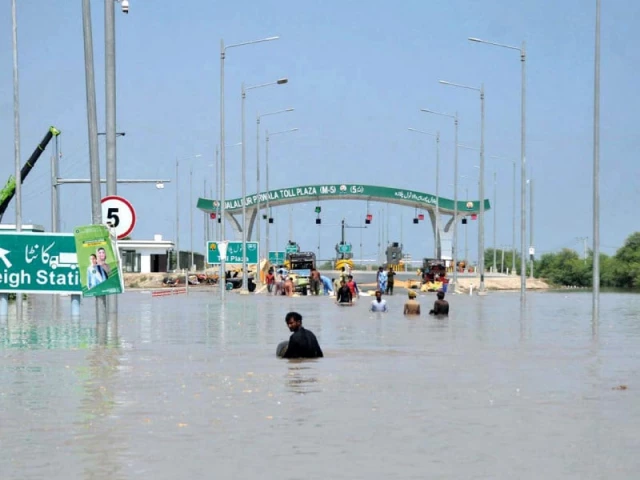The devastating floods swept across Punjab, Sindh and the southern parts of Pakistan continued to escalate Monday, leaving widespread destruction, displaced millions, and pushed the nationwide death toll to nearly 1,000. At Guddu Barrage in the Kashmore-Kandhkot district, where the Indus River first enters Sindh, the authorities registered a marginal decline in flood levels, but the pressure was mounted at downstream Sukkur Barrage. The power at Guddu, which stood at 635,759 CuseCs at. 06, fell by more than 11,000 CUSERCS within six hours and settled at 624,456 CUSSCS in the evening. By comparison, Sunday night had registered 612,269 CUSSCS. Despite the slight easing, evacuations continued from river villages. SUKKUR BARRAGE reported 560,890 CUSERCs on Monday night – a sharp increase of 72,000 CUSSCS in 24 hours. Kotri Barrage also saw an increase that touched 284,325 CUSSCS in the evening, although it remained at a low level of flood. Irrigation officials said so far that no violations had been reported on violations or overpowering dams, but riverbosses and agricultural land had been flooded. In Ghotki, flooding water entered the Oil and Gas Development Company Limited’s (Ogdcl) gas field in Qadirpur and forced suspension of drilling at 10 wells. The company’s officials said the operations would resume when the water was withdrawn. Meanwhile, the humanitarian crisis was elaborated on Punjab and Sindh. Heavy monsoon rains combined with the rolling river stream destroyed infrastructure, including a section of Multan-Sukkur M-5 highway near Jalalpur Pirwala. The washed shared part forced a full closure, while emergencies on a bridge were stopped due to dangerously strong currents. The collapse interrupted an important transport route that complicated the supply of relief. In Uch Sharif detached a 100 -foot wide violation in a dam torrents in residential areas and agricultural land that flood the sanctuary of Mian Mouluk Shah Bukhari before spreading in the surrounding villages. Accidents also mounted: A man drowned in Muzaffargarh, two children died in Multan, and four perished more in Balochistan’s Kohlu District. According to the National Disaster Management Authority (NDMA), the total death toll has been reached 992 since the end of June, with 1,062 people injured and more than 4.5 million directly affected. Punjab has borne the destruction of the destruction. Flooding Sutlej and Chenab rivers immersed dozens of villages. In Chishtian, 47 villages went under water, drowned 48,000 hectares of agricultural land and wiped out sugar cane, rice, maize and sesame crops. Minchinabad saw 67 villages immersed along a 76 kilometer belt that affects more than 56,000 people. In Alipur, dozens of villages remain marooned, with home, schools and roads damaged without repair. Residents complain about the shortage and utilization of private boat operators, some charge up to RS40,000 to ferry families and livestock in safety. In Uch Sharif, 36 villages were flooded, thousands of hectares lost agricultural land and families were stranded. Sindh is facing a parallel disaster. In Ghotki, cotton and sugar cane crops have been destroyed, and villagers forced to give up home, leading cattle to higher soil in a last ditch attempt to save livelihood. Health officials warned of a threatening health crisis and issued Dengue alarms for Karachi, Lahore, Islamabad, Faisalabad and Peshawar as stagnant water provided breeding grounds for mosquitoes. Hospitals have been ordered to stay in high attention and fumigation campaigns have been announced. Auxiliary and rescue efforts continue, but remain stretched. NDMA reports that more than 2.95 million people have been rescued nationwide since June, with over 151,000 house in emergency camps. More than 473,000 patients have received treatment in medical camps, but many communities remain cut off, with air lifter and both the only means of access. Punjab Chief Minister Maryam Nawaz visited Alipur on Monday, monitored relief operations and personally distributed help. At a relief, she served meals, handed out compensation checks and secured long -term rehabilitation. Officials informed her that nearly 394,000 people in the Muzaffarh district had been affected alone. Survivors required urgent action to repair cushions and restore food and shelter. Maryam praised the role of the marine in rescue operations and announced the creation of a dedicated WASA Punjab strength to improve the future flood response. Separately approved Punjab Education Foundation RS5 Billion to rehabilitation of flood -damaged schools. Nationally, Tarbela Dam is in full capacity and Mangla Dam of 95%. The federal flood commission reported extensive damage since the end of June: 674 kilometers of roads, 239 bridges, 8,481 homes and over 6,500 livestock lost. Adding to the crisis predicts Pakistan Meteorological Department a fresh spell with heavy monsoon rain, which begins Tuesday (today) and lasts through September 19, with rawalpindi, Lahore and Gujranwala among the areas in danger. Officials warn that the new rain could trigger further floods in already destroyed regions. Currently, residents of Punjab and Sindh, who are already struck with weeks of flooding, remain on the edge – trying to save what they can do when supporting another wave.
Deluge ebbs but trial waves



